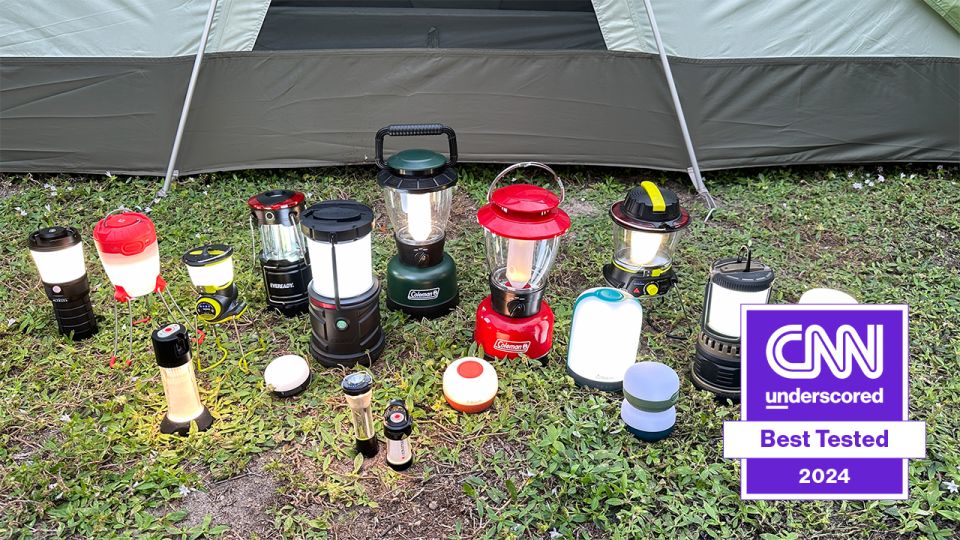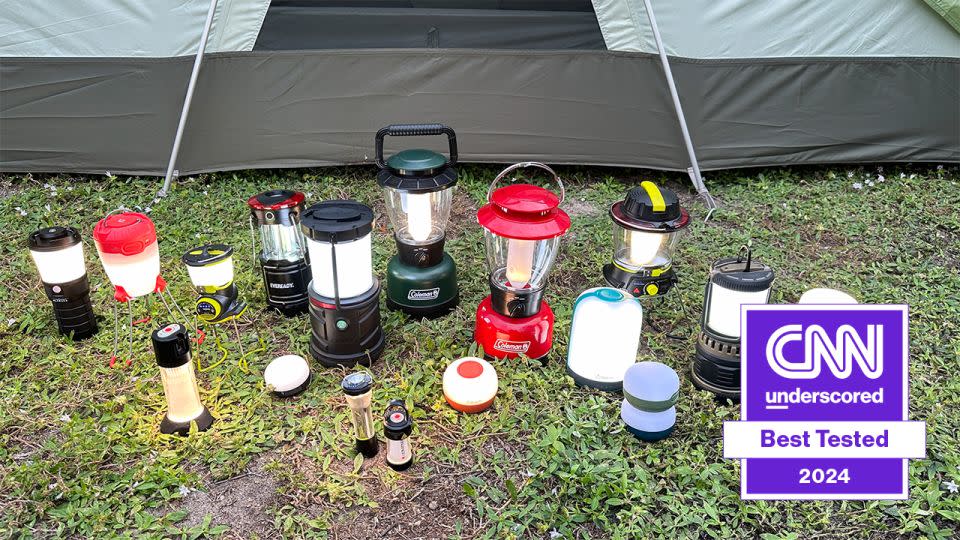
Flashlights and headlamps are great for focused, directional beams, but for illuminating a wide area with useful, ambient light, you need a lantern. These portable devices provide 360-degree output, which is perfect for nighttime activities like socializing around a picnic table, brightening up the inside of a tent or using as a light source during a power outage. Plus, unlike the bulky, gas-powered contraptions you might imagine, modern lanterns are available in a wide variety of sizes, with bright LEDs and user-friendly controls.
I put 14 of the top models through a rigorous testing process, evaluating them on overall ease of use, battery run time, versatility and durability. After weeks of using these lanterns inside my home, camping tent and car, as well as wandering through dense Florida brush after dark, I found the BioLite AlpenGlow 500 to be the top lantern overall. The Coast EAL22 and Black Diamond Moji R+ were also strong finishers, distinguishing themselves as the best budget-friendly and compact options.
BioLite AlpenGlow 500
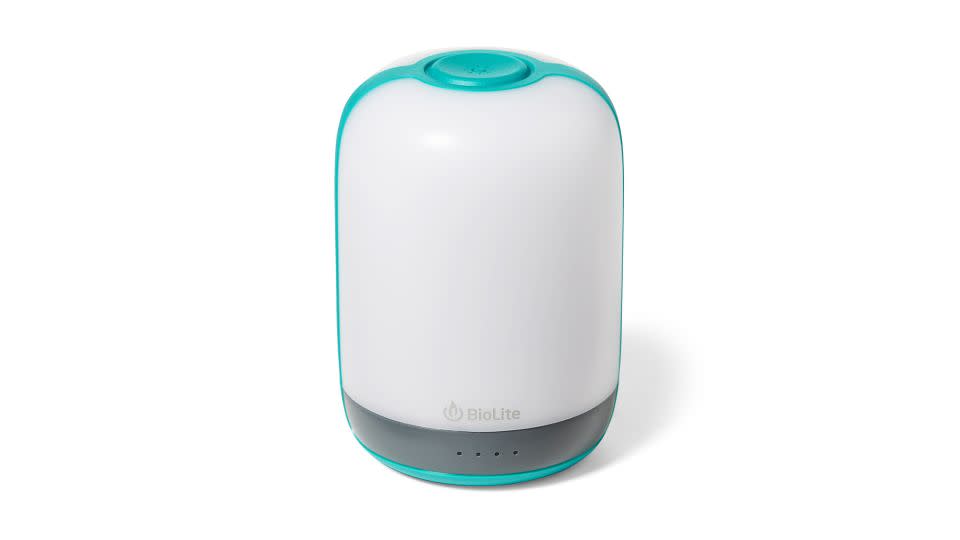

With a large surface area, soft light output and a ton of features (including a convenient half-beam mode) the Biolite AlpenGlow 500 topped our tests as the best lantern for most people.
$80 at BioLite
$80 at Amazon
$80 at REI
Coast EAL22
Best budget lantern
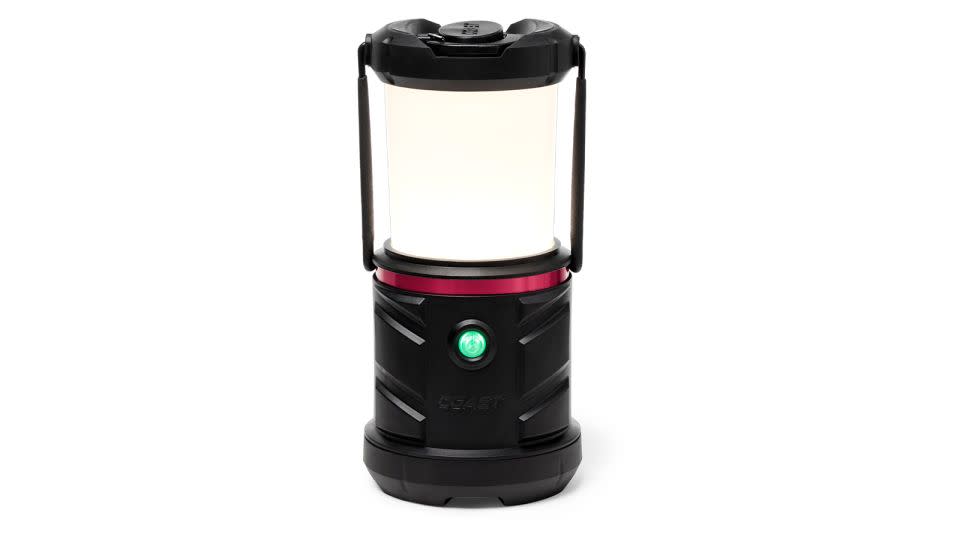

Featuring a beefy, rugged build and a user-friendly single-button control, the Coast EAL22 is a low-cost option that doesn’t compromise on durability.
$30 at REI
$44 at Amazon
Black Diamond Moji R+
Best compact lantern
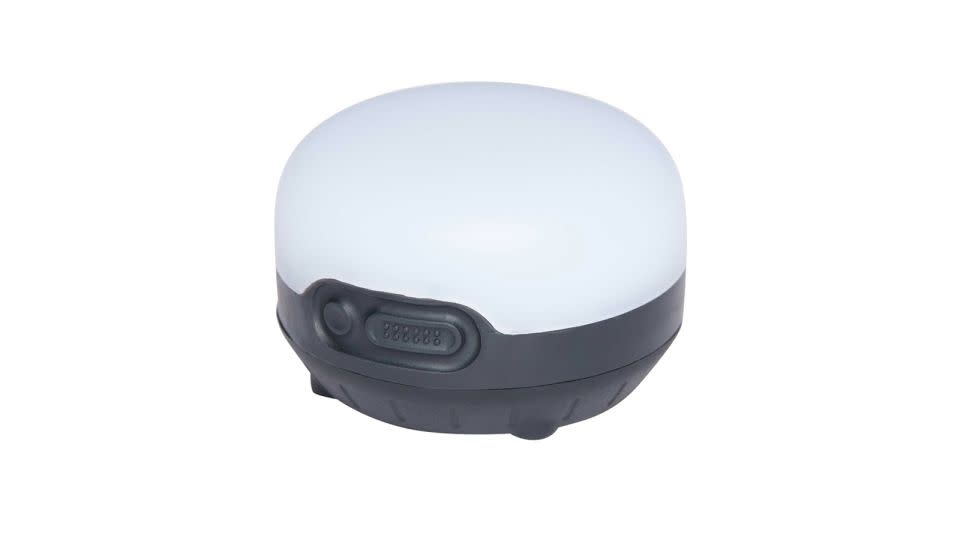

This tiny lantern packs a ton of functionality into a small package, with more modes, settings and light options than most other lanterns we tested, making it a great choice for those who want to save on space and weight.
$45 at Black Diamond
$45 at REI
$45 at Amazon
Best lantern: BioLite AlpenGlow 500
$80 at BioLite, Amazon and REI
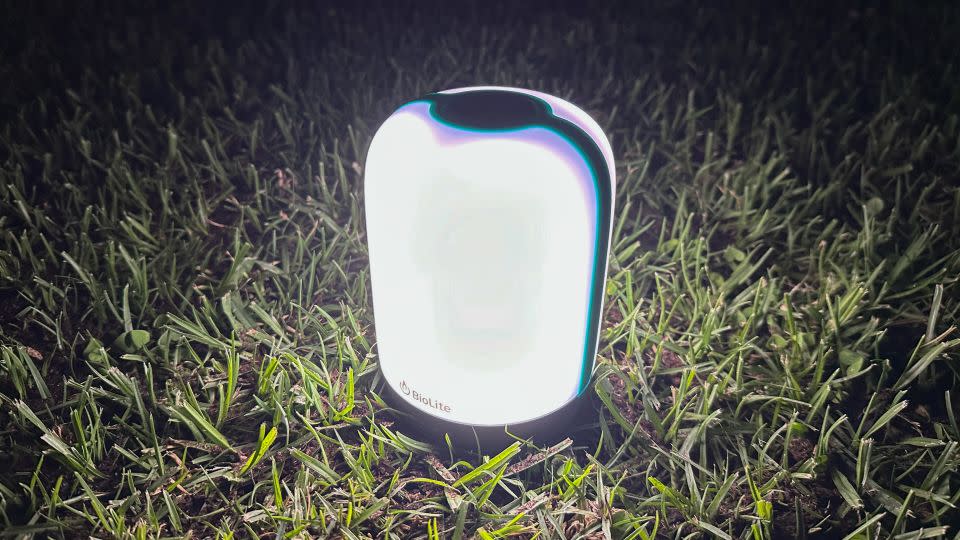

With a soft and eyesight-friendly light output, a variety of settings and a user-friendly interface, the Biolite AlpenGlow 500 hits that sweet spot of functionality and usability. This rechargeable LED lantern also packs an internal 6,400mAh battery that can be used to charge external devices, making it especially useful for camping and emergency use.
Although I was initially intimidated by the number of light modes, settings and speeds (more than any other lantern I tested), the Biolite AlpenGlow 500 was actually easier to use than I expected. Don’t get me wrong, I still had to consult the manual and spend about 30 minutes of practice to really get the hang of the controls, but considering the sheer amount of settings, the Biolite interface did about as good of a job as it could with a single-button interface. Although this interface wasn’t as easy to pick up as some of the more bare-bones lanterns we looked at, it was still less complicated than others, such as the Sofirn BLF LT1.
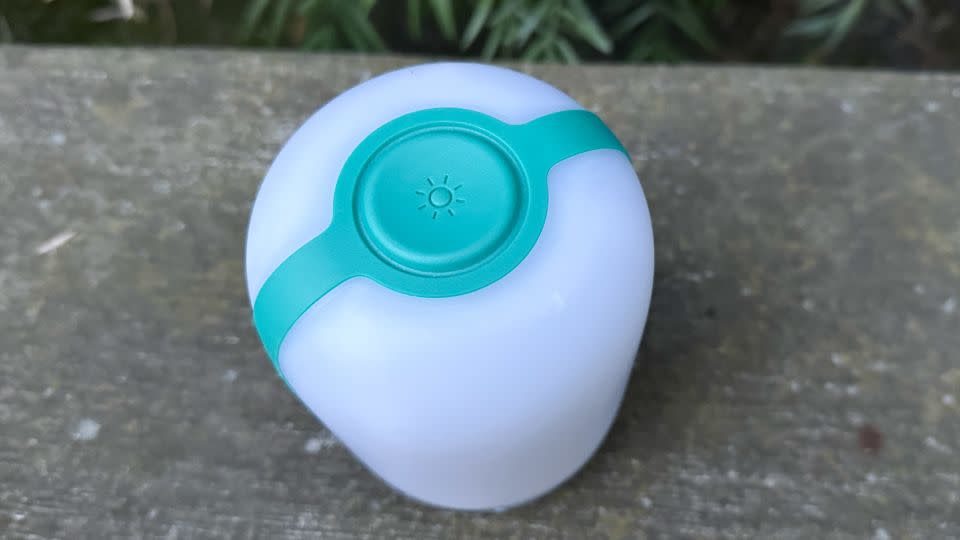

In addition to standard, dimmable cool and warm light options, you can also choose from a range of colors, a multi-colored party mode and a warm candle flicker that I found to be especially enjoyable. The only other lantern to come close to this variety was the Black Diamond Moji+, which is much smaller and also lacks cool and warm light-tone options.
Do you really need all these different light modes? Not really, but they can really add some fun to your campsite. The multi-colored party mode is a great way to entertain the kids and the warm candle flicker can act as a relaxing campfire replacement. I think they add a lot of value and really make the AlpenGlow special, but if you don’t need all the fancy lights and colors, check out our budget pick, the simple Coast EAL22.
My favorite feature of the Biolite AlpenGlow 500, and one that I found to be curiously missing from the majority of lanterns I tested, was a half-beam mode. A quick shake of the lantern switches off one half of the lantern, allowing you to direct the beam away from you and use it as more of a directional tool. While the AlpenGlow’s soft diffuser does a great job of reducing glare, it’s still nice to give your eyes a break without having to shut the lantern off altogether.
The Biolite AlpenGlow 500’s impressive battery run time — lasting 11 hours when set to its highest brightness setting — was also another factor contributing to its selection as my top overall pick. This run time was one of the longest during my testing, and although it was surpassed by a couple of the larger units (as well as the tiny Black Diamond Moji R+), I feel that the functionality and output of the Biolite AlpenGlow 500 make for a worthy compromise.
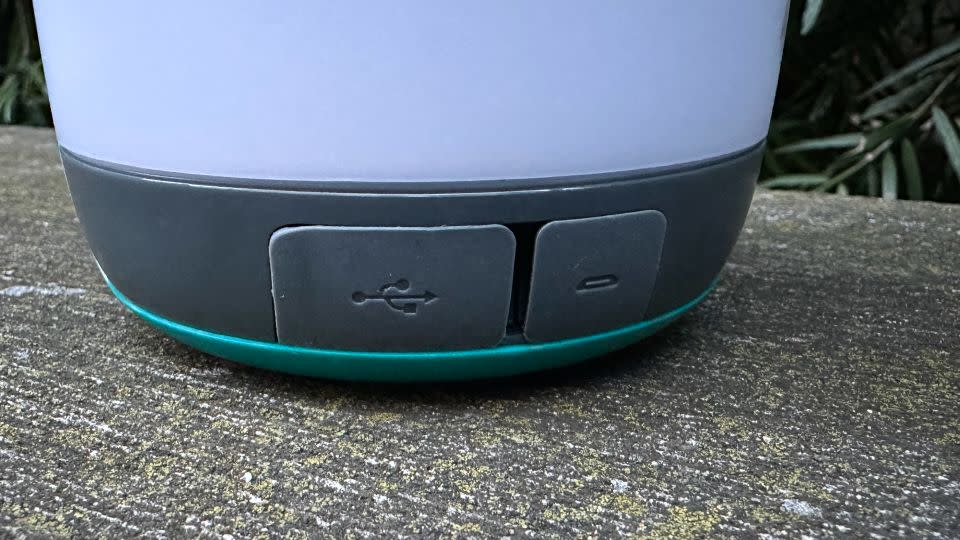

Thick rubber covers protect the Micro USB and USB-A external charging ports from moisture and debris, and four bright LEDs on the bottom of the unit indicate the current battery status. I personally find this four-LED design superior to the colored lights of some other models I tested, but your preference may differ. When completely depleted, charging the internal battery back to 100% took just three hours, which was among the fastest of any in my testing pool. Only the much smaller Ledlenser ML4 charged faster, clocking in at 2.5 hours.
This internal battery (and USB-A output port) also functions as a power bank for charging external devices like smartphones or string lights. Although nine of the lanterns in my testing pool feature external charging ability, the 6,400mAh capacity of the Biolite AlpenGlow 500 was higher than all but one: the 10,400mAh Streamlight Super Siege 44947. Despite this impressive capacity, the relatively short five-hour run time ultimately kept the Super Siege out of a top spot. It’s important to remember that this mAh conversion isn’t a one-to-one exchange, and a lot of this energy is lost during the charging process. In my experience, it’s best to assume that you’re only getting about half of your full mAh capacity when charging another device. When I tested it out, the 6,400mAh capacity of the Biolite AlpenGlow 500 was almost completely depleted after charging my dead iPhone 14 Pro’s 3,200mAh battery from 0 to 100%.
This lantern also performed really well while field testing inside my tent. The built-in hook on the bottom made it simple to hang, and the rounded shape helped ensure full-coverage illumination, with minimal floor shadows underneath. This design — which creates a lightbulb-style output — was much more effective than lanterns that hung from their top, which tend to spread out and upwards, leaving the floor of the tent — where you need the light the most — with the least-effective illumination. This also makes the button convenient to press from underneath, as opposed to other lanterns whose side-mounted controls could be oriented away from you.
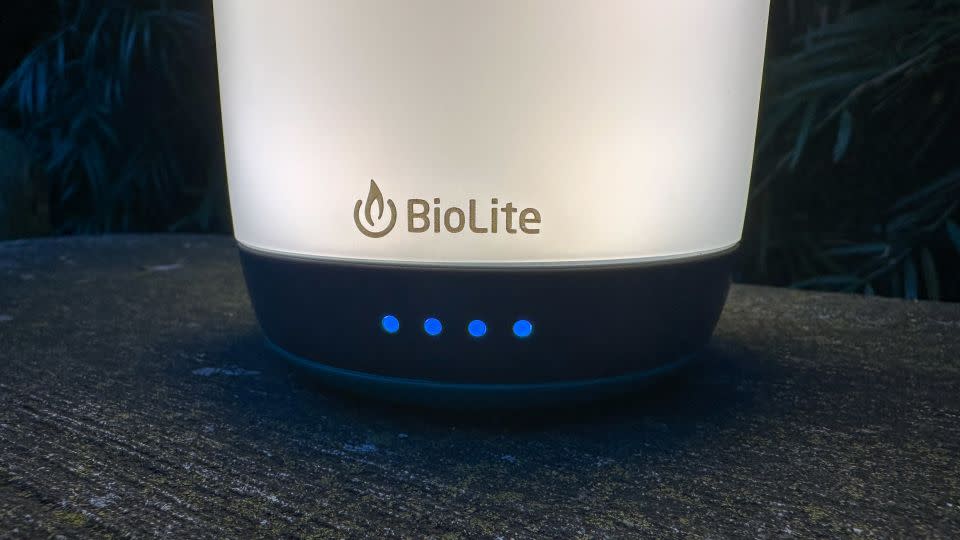

I also appreciated its stocky build and flat bottom, which made the lantern easy to place on a picnic table or other flat surface without tipping over too easily. Plus, due to its height, the beam did a better job than the smaller, flatter lanterns of spreading a wider beam across the surface. And again, the top-mounted button was easy for anyone around the table to reach and press without having to hunt for it.
This combination of power, run time, output options and external charging makes the Biolite AlpenGlow 500 equally practical for utilitarian use like illuminating a tent or picnic table, lighting up a pathway as you walk, or as part of an at-home emergency kit.
Best budget lantern: Coast EAL22 Lantern
$30 at REI or $50 $44 Amazon
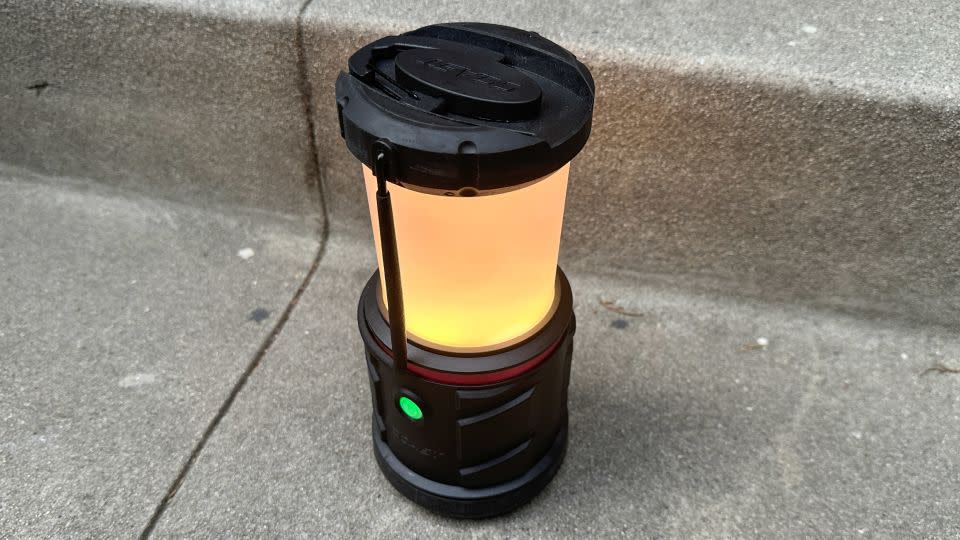

If you’re looking for a simple, no-frills, full-size lantern that won’t break the bank, the Coast EAL22 lantern is a great option. With straightforward controls and enough light modes and settings for basic illumination tasks, this rugged lantern might not be as exciting as the Biolite AlpenGlow 500, but it will light up your campsite, car or living room at a fraction of the price.
Despite the low price, this beefy unit has a solid, sturdy feel to it, with thick rubber covering the base and top. Although not as seemingly indestructible as the similarly-sized, but much more expensive, Streamlight Super Siege 44947, the rugged build of the Coast EAL22 was far superior to the flimsier construction of other lower-priced, full-size units (like the Coleman Rugged Rechargeable 400L LED or Coleman Personal LED Lantern). Its 9-inch height and large folding carrying handle help give it that classic lantern look, and the carabiner clips on the top and bottom are secure and robust as well.
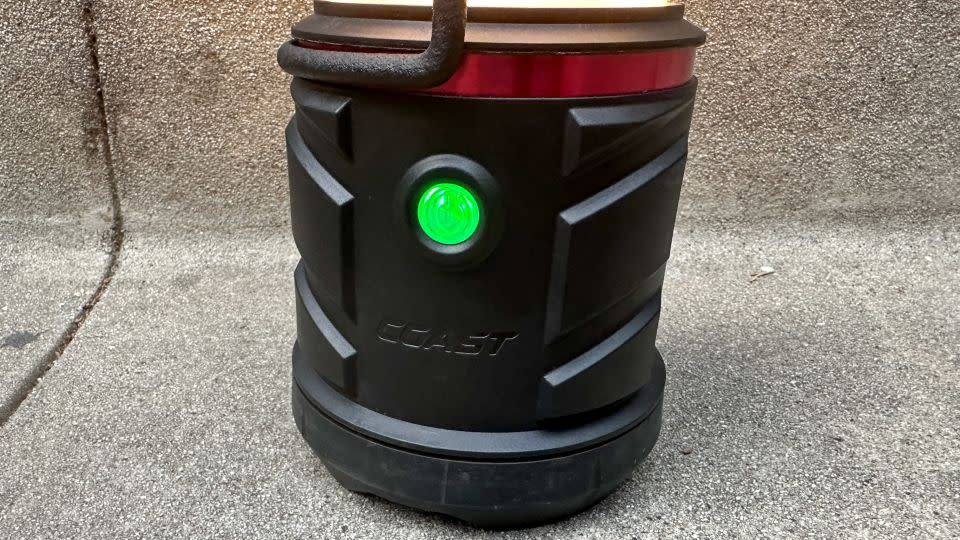

A simple, single-button control cycles through the three brightness settings, and a long press switches over to solid or flashing red mode. This straightforward interface was one of the easiest to understand and use out of all the lanterns I tested, and — due to its limited settings — much less complicated to use than feature-heavy options like the Biolite AlpenGlow 500. The three settings cycle the lantern through low, medium and high brightness levels, while a thick diffuser softens the impressive 1,125-lumen output. However, if you want to expose the raw LEDs when hanging the lantern upside-down, you can remove the diffuser for extra brightness.
The only lanterns easier to understand would be those with labeled control knobs, like the Coleman Rugged Rechargeable 400L LED and Coleman Personal LED Lantern (whose cheap construction makes them a durability liability), and the Goal Zero Lighthouse 600 and Goal Zero Lighthouse Mini, whose under-four-hour run times kept them out of our top spots.
The Coast EAL22 runs on three D batteries (not included) which provide nearly seven straight days of power (although it naturally dimmed over time). This run time was longer than any other lantern I tested, the majority of which lasted less than 24 hours. If you don’t want to spend money on batteries all the time, you can also purchase a Coast rechargeable battery pack for an additional $33. I sourced one of these battery packs for testing, which lasted an impressive 11 hours — the same as our top overall pick, the Biolite AlpenGlow 500 (although it takes up to 12 hours to recharge).
The battery level indicator of the Coast is less informative than other lanterns — the power button simply changes from green to red when it’s running low — but the long run time makes this less of an issue. Considering this lantern lasts for a mind-bogglingly long time, can run indefinitely as long as you have D batteries and can use a rechargeable pack if you prefer, this lantern would be a perfect addition to your home emergency kit.
The drawback to this long run time is that, due to the D batteries, the Coast EAL22 weighs in at a hefty 42 ounces (almost 3 pounds), which is substantially heavier than the Biolite AlpenGlow 500 (14.5 ounces). This might not be a big deal for home use, but hikers would probably prefer something a bit lighter. It’s also nearly twice as tall as the AlpenGlow (9 inches compared to 5.25 inches), so those looking to conserve space in their pack may want to opt for a less bulky option.
Another potential drawback to the Coast EAL22 is the lack of light mode varieties, especially compared to the plethora of options on the Biolite AlpenGlow 500. Even if you’re not interested in multi-colored light shows, the lack of a dimmable beam has a big impact on the versatility of the Coast EAL22, and I missed having the ability to use an extremely low brightness level, which was a feature in the majority of the lanterns I tested.
The Coast EAL22 definitely isn’t perfect, but if you don’t need a wide range of settings and want a low-cost tool that provides light for a long time, you can’t beat it.
Best compact lantern: Black Diamond Moji R+
$45 at Black Diamond, REI and Amazon
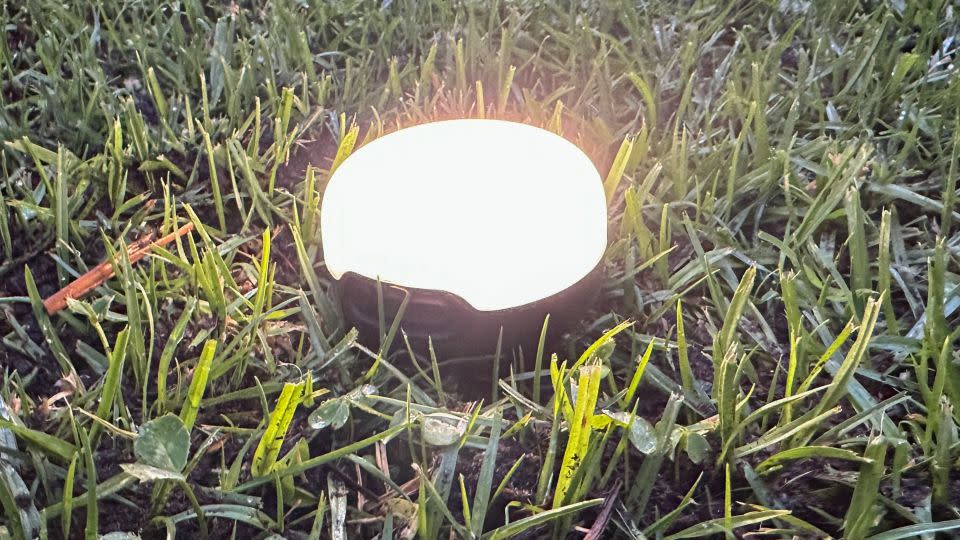

Despite its small size (seriously, this thing is tiny) the Black Diamond Moji R+ has just as many bells and whistles as full-size lanterns. Measuring just 2.25 inches in diameter and 1.5 inches tall, this compact light can fit pretty much anywhere, making it perfect for hikers, car campers and anyone else who prefers to cut down on bulk and weight wherever they can.
The Black Diamond Moji R+ boasts a range of light settings and color modes — as many as or more than many of the full-size models I tested. In addition to a dimmable white light setting, it offers a full spectrum of colors, a color-changing color cycle and an amber-colored campfire mode that appears to flicker and pop like actual flames. Navigating through these settings was actually much easier than I expected, and after a few minutes of reading the manual, the two-button interface became second nature.
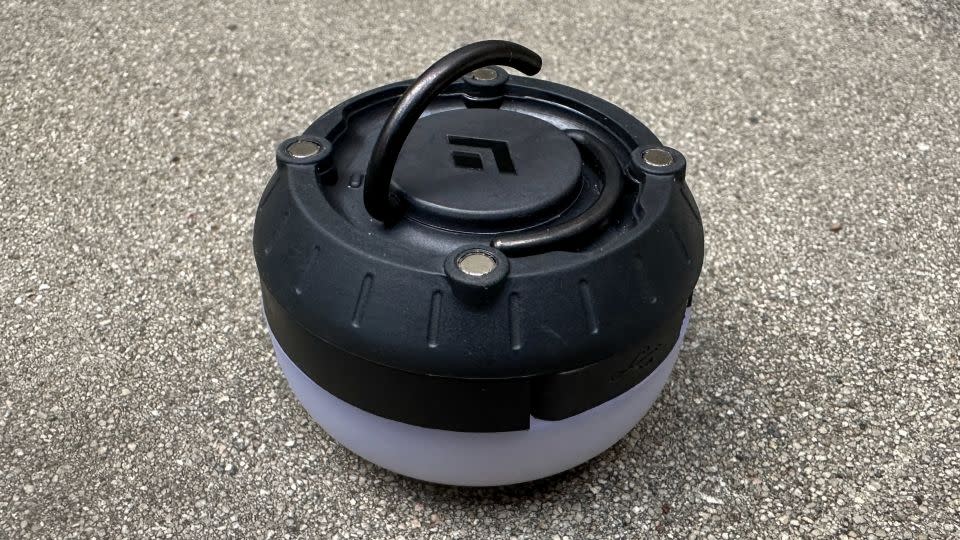

The low-profile shape is perfect for simply placing on a picnic table or tent floor, and the two interlocking hooks make it easy to hang from a loop or lanyard. It also features four recessed magnets underneath the base, adding even more mounting versatility (I found that only two of these magnets required contact for the lantern to hold steady).
The small size of the Black Diamond Moji R+ does mean you’ll have to compromise a bit on brightness and power, but the 200-lumen output is still perfectly adequate for close-range use. It illuminated all four corners of my tent when on its highest brightness setting, and I found it to be especially convenient for use inside my car, where a brighter (and bulkier) option would have been more cumbersome and overkill. It’s worth noting that this relatively low lumen output likely contributes to the impressive run time of the Black Diamond Moji R+, which lasted 13 hours and 30 minutes before draining completely. This was two hours longer than our top pick overall, the Biolite AlpenGlow 500, and was only surpassed by the Coleman Personal LED Lantern, Coast EAL22 Lantern, Sofirn BLF LT1 and Ledlenser ML4. The Ledlenser ML4 is the only one of these long run time options that’s just as compact as the Black Diamond Moji R+, but it lacks the extra light settings and modes. If you want a compact lantern that’s more bare-bones but has more run time, the Ledlenser ML4 is $5 cheaper and a great pick.
While it’s not going to blow you away with lumen output or distance, if you’re interested in a lantern with a ton of bells and whistles — and don’t have the space or need for a larger, more powerful model — the Black Diamond Moji R+ is the lantern for you.
Do I need a lantern?
Lanterns aren’t exactly essential, but for certain situations, they’re much more convenient and practical than other lighting options. Unlike a flashlight or headlamp that requires you to hold and aim a focused beam, lanterns are designed to stand — or hang — on their own, throwing 360 degrees of light across a wide area. This hands-free operation and full-coverage beam are perfect for illuminating areas like campsite picnic tables, the inside of your vehicle while car camping or a tent. This also makes them a valuable addition to a home emergency kit, where a general, all-purpose light is more convenient for lighting up a home during a power outage.
Lanterns also have the ability to dim and adjust their brightness settings more than flashlights and headlamps, allowing you to better customize the output to your specific task. Their broad, diffused beams aren’t well-suited for long-distance or directional use, which is why you should still have a flashlight or headlamp handy.
What should I look for in a lantern?


The most important factor to consider when choosing a lantern is that you’re able to use it effectively. While all models provide a steady, adjustable light source, many also offer an array of additional settings, colors and light modes. These extra bells and whistles are nice to have on hand but also have a steeper learning curve than a basic option, which may be inconvenient to operate if you don’t use it very often. If you don’t want to worry about remembering how to operate your lantern — especially during emergency situations — a lantern with fewer settings is probably a better choice.
When choosing a lantern, think about the design elements that would be most useful to you and your needs. If you want to hang your lantern, like inside of a tent or along a piece of paracord, and illuminate the area below it, make sure it features some kind of hook or loop for doing so. Those looking for a lantern to help illuminate an outdoor path or a darkened house should look for a model with a comfortable carrying handle.
You should also take size and weight into consideration when choosing a lantern. While larger and heavier lanterns typically provide a brighter beam, they’re also less convenient to transport, especially if you plan on traveling long distances. On the other hand, if you plan on using your lantern at a drive-up campsite or as part of an in-home emergency kit, portability is less of an issue.
A lantern’s power source and charging capabilities should also be taken into account. Most modern lanterns are either powered by an internal rechargeable lithium-ion battery or traditional replaceable batteries. Internal lithium-ion batteries are convenient to charge — you just need a USB port — and don’t require the additional expense and hassle of replacement when they run low. But if you lose access to a power supply, like on a long hike or in a power outage, their limited run time can be an issue. On the other hand, if your lantern accepts replaceable batteries, you can keep swapping out dead batteries for new ones as long as you like. If you’re concerned about run time, but still want the convenience of a rechargeable lantern, look for a model that uses both battery types, like the Black Diamond Apollo, Black Diamond Moji R+, Ledlenser ML4 or (if you purchase the additional battery pack) the Coast EAL22.
To be even more prepared for power-related issues, such as a lantern specifically chosen for an emergency kit, consider a lantern that can charge external devices, like the Black Diamond Moji Charging Station Lantern or Streamlight Super Siege 44947. Even if you don’t plan on using this feature regularly, having a portable power source on hand — especially one that can convert replaceable batteries into power for a drained smartphone — could really come in handy.
How we tested
Although all lanterns perform roughly the same task, individual models can differ in many ways. To help differentiate between options and better recommend them for specific applications, I ran them all through an extensive testing process.
Since lanterns are typically used infrequently and commonly in low-light conditions, it’s important that they’re easy to use. I compared each model’s user interface by exploring its different settings and light modes, noting how simple or complicated they were. I also reviewed each lantern’s instruction manual, judging how well it explained and walked you through the controls and setting options.
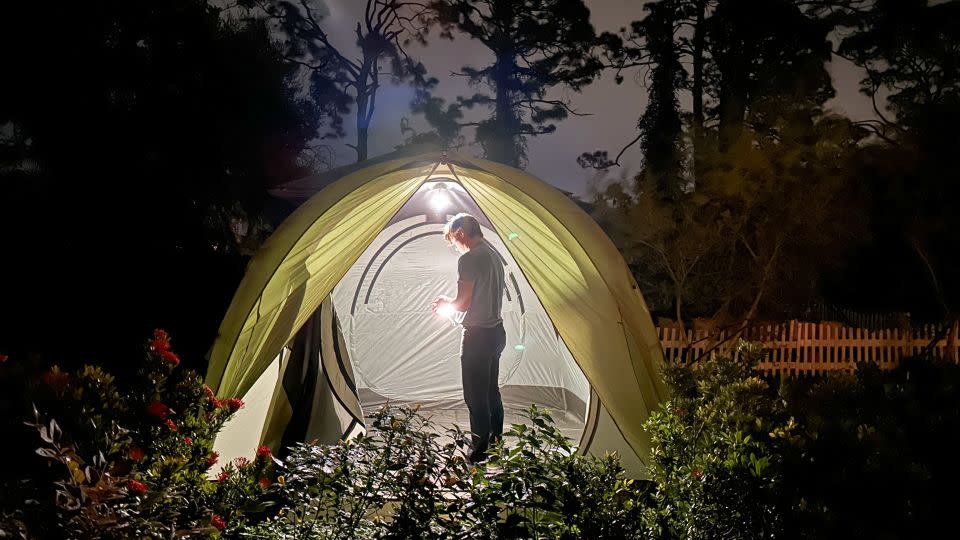

For a more real-world test, I brought the lanterns outdoors and used them inside my REI Co-op Wonderland Tent at night. I evaluated them on how convenient they were to hang from the ceiling, how effectively they illuminated the tent’s interior and whether they created any annoying shadows. I also judged how far each lantern’s light output was able to travel out in the open, as well as inside my own living room (it’s worth noting that lanterns aren’t exactly designed for long-distance illumination, and are much more practical for short-range use, but I still felt that this was a useful test to judge overall functionality).
To compare the run time of each lantern, I turned each model to its highest beam setting and timed how long it took the battery to drain. I also noted whether or not each lantern featured any kind of battery status indicator and, if so, how effective it was (while most used a four-LED indicator, others used color-changing buttons or LEDs that were typically less straightforward).
To get an idea of the overall functionality of each lantern, I compared the quantity of light and beam settings, as well as any alternative colors (a red light option is always a nice perk for conserving night vision) or aesthetic settings like multi-colored light shows or flickering candlelight modes. I also noted whether or not the lantern’s internal battery had the ability to charge external devices, which would be convenient for any user, but particularly for emergency or camping use where a dead cell phone could be a serious issue.
I also tested the overall durability of each lantern by inspecting and evaluating any moving parts and smaller components, noting whether they felt flimsy and cheap or sturdy and well-made. If the lantern boasted about its waterproof or drop rating, I made sure to test those in my shower or by dropping them on the ground.
During these tests, I noted the overall quality of the light produced by each lantern. While some featured diffusers to create a soft, eye-pleasing glow, others had bright glares and hot spots that were annoying to look at.
Other lanterns we tested
Black Diamond Apollo
$70 at REI and Black Diamond
A fine runner-up to our top pick, this 250-lumen Black Diamond lantern packs a ton of useful features into a compact unit. Two hanging hooks and folding tripod legs are convenient for suspension as well as tabletop use, and the rubber feet give it a nice sturdy grip. The internal rechargeable battery can also be used to charge external devices via a USB port, and its seven-hour run time ranked around the middle of the pack in my testing pool. If this internal battery runs dry, this lantern also has space for three AA batteries, which can take over and continue operation.
The primary differences between this lantern and the Biolite AlpenGlow 500, and why I ultimately chose the latter as our top pick, are its lack of red light mode, and the fact that the run time was more than four hours shorter. If those aren’t an issue for you, and you prefer the minimal UI of a single-color lantern, this is a fantastic option.
Black Diamond Moji Charging Station Lantern
$80 at REI and Black Diamond
This unique lantern functions just as well as a dedicated charging station, with a USB port for external charging and three power source options (AC adaptor, rechargeable internal lithium-ion battery or four standard AA batteries). Two separate battery status indicators provide real-time status of both the lithium-ion and AA batteries, with bright, easy-to-read LED displays. The single-button control is about as simple as it gets, with a single press to power it on and off and an extended press to adjust the dimmer. When hung by the built-in hook loop, this lantern also did a great job of illuminating the inside of my tent. The main drawback of this lantern was its relatively low 250-lumen output, which created a smooth, ambient light, but didn’t provide the distance of the Biolite AlpenGlow 500, which did a much better job of illuminating my dark living room.
Black Diamond Moji
From $25 at Amazon and Black Diamond
If you’re just interested in a basic, hassle-free light source that won’t take up much room, you’re not going to do much better than the Black Diamond Moji. This simple, compact lantern measures less than 3 inches in diameter, making it perfect for slipping into a coat pocket or backpack compartment. A single control button powers the 200-lumen light on and off, and a long press dimms it up and down. The frosted globe produces soft, consistent light and the double-hook hang loop is convenient for suspending in your tent or from a cord above your picnic table. Although this lantern isn’t technically rechargeable (it runs on three AAA batteries), if you’re comfortable spending another $30, it also accepts a Black Diamond 1500 lithium-ion rechargeable battery. We consider the additional lighting options (particularly the red beam setting), and rechargeable battery of the Black Diamond Moji R+ to be worth the extra $15, but if that’s not in your budget, this model is still a great value.
Black Diamond Moji+
$30 at REI and Black Diamond
Combining the affordability of the Black Diamond Moji and the colorful light options of the Black Diamond Moji R+, the Black Diamond Moji+ is a practical compromise between the two. An interlocking hanging hook and a magnetic base make it easy to mount and hang, and the curved lens did a great job of casting a broad beam of light around my tent during testing. This little lantern runs on either three AAA batteries or a Black Diamond rechargeable unit (sold separately). This power versatility is useful, but the lack of a battery level indicator — which was present on most other options — and a five-hour run time compared to the 13.5 hours of the Black Diamond Moji R+, ultimately kept this out of a top spot. The dual-button control system takes a little more practice than the single-button Moji, but the multicolored options, including a flickering “campfire” setting, could be worth it for those who value a range of settings.
Goal Zero Lighthouse 600
$70 $56 at Amazon, REI or Goal Zero
This jack-of-all-trades lantern is packed with features and has one of the best control interfaces I tested. A single neon green control knob activates and controls the brightness level of both the full and half beam, and a red triangle button activates a flashing red strobe light. Since the bright LED of this model isn’t as diffused as other lanterns — resulting in a pretty bright glare at full power — the half-beam feature is especially useful. Two folding legs and a large carrying handle on top make it easy to transport and set up, and a built-in USB charging cord means you don’t have to track one down when it’s time to charge. What I didn’t like about this lantern was its short run time. At three hours on high, this was one of the worst performers in that testing category. The lack of a cover on the USB output for external charging makes me a little nervous too, and unlike almost every other model I tested, this one provides no waterproof rating.
Goal Zero Lighthouse Mini
$40 $32 at Amazon, REI and Goal Zero
The compact version of the Goal Zero Lighthouse 600, the Goal Zero Lighthouse Mini features the same user-friendly control dial for full- and half-beam output, as well as a built-in USB charging cable. The folding legs help raise it above the surface for better tabletop illumination, a foldable hook on top allows you to easily hang from a branch or rope and a strong magnet on the base is convenient for mounting on metal. Four large LEDs clearly show the current battery life, and the 2,600mAh battery can also charge external devices. It did have the same short run time as its older sibling though, and the design of the unit wasn’t great for illuminating underneath when suspended in the air.
Goal Zero Lighthouse Micro
$25 $20 at Amazon, REI and Goal Zero
This multifunctional lantern works just as well as a directional flashlight, and its tiny size (4.4 by 1.5 inches) is perfect for tossing into a jacket pocket, purse or backpack. The one-button control is simple to figure out, and a single press cycles through flashlight, half-lantern and full lantern settings. Although the downward-facing lantern LEDs aren’t the best for distance, they’re really convenient for tabletop and hanging use. However, these LEDs are harsh on the eyes — especially on high — and lack the soft diffusion that makes the Black Diamond Moji R+ such a great pick. The integrated USB input port of the Lighthouse Mirco means you don’t have to carry around a separate cord, but does pose some challenges if connecting to ports in awkward or tight areas. A separate output USB allows for external device charging, and the 2,600mAh internal battery lasted a lengthy 11 hours and 40 minutes of continuous run time before shutting off.
BioLite AlpenGlow Mini
$40 at BioLite, REI and Amazon
This little light has plenty of color options and the soft, warm light is especially easy on the eyes. The single-button control takes some practice, but in my opinion, BioLite did a great job of making the UI as intuitive as possible. An integrated bungee strap and T-hook make it easy to affix to branches and tent loops and four bright LEDs provide a real-time battery status. The 150-lumen output isn’t going to be practical for large spaces or distances but I found that it did a fine job lighting up the inside of my tent (although not as completely as the 200-lumen Black Diamond Moji R+).
Coleman Rugged Rechargeable 400L
$65 $43 at Amazon
It’s not the most robust, and the 4.5-hour run time (on high) ranked toward the bottom of my testing pool, so if you’re looking for a classic lantern that’s simple to use, the Coast EAL22 is superior to this one in nearly every capacity. That being said, if you prefer a rechargeable internal battery, and don’t want to purchase a separate one for the Coast, this could be a relatively cheap alternative. A large handle and sturdy base make it comfortable to transport and place wherever you need, and the high/low/off dial couldn’t be any easier to use. Although the entire unit felt fairly cheap and flimsy compared to higher-quality lanterns, the usability could make it a decent option to toss into an emergency kit. Just don’t expect it to be durable enough for intense camping or hiking use.
Coleman Personal LED Lantern
$26 at Amazon
This low-cost lantern has a mind-bogglingly long run time but isn’t durable enough for heavy use. Powered by four D batteries, its LED light lasted for well over 100 hours before becoming too dim to be useful, which is far and away the longest of all the lanterns I tested. The thin metal carrying handle isn’t the most comfortable, although it does unclip for attaching to a fixed loop (like the one on the ceiling of my tent). Despite these issues, the rock-bottom price is difficult to pass up, at least for use as a backup lantern to toss into a closet or trunk of your car. If you’re open to spending more though, the Coast EAL22 is a far superior option with a similarly long run time.
Ledlenser ML4
$40 at Amazon
I’m a big fan of Ledlenser products, and this little lantern is a great example of the brand’s high-quality construction and user-friendly design. A large rubber control button on top of the unit easily adjusts the brightness level of both the white and red light options, and the integrated carabiner clips to your keychain or a backpack loop. This lantern also uses a micro-prism design that actually directs the light downwards, greatly reducing glare, even at full power. Its rechargeable battery lasted 16 hours before dying completely — only two lanterns lasted longer — and can also be replaced with a standard AA battery. My main issue with this lantern is the fact that the power cord connects via a magnetic connection. While this unique design is convenient and isn’t vulnerable to moisture like an open port, I prefer a more common USB-type cord that’s easy to replace if lost or damaged.
Ledlenser ML6
$90 at Amazon
With a sturdy magnetic base, built-in hook and removable rubber hanging loop, this Ledlenser lantern is convenient to use pretty much anywhere. The two sides of the loop also act as tight-fitting, water-resistant covers for the charging input and output ports, making them easy to access whenever you’re ready. The large rubber on/off button is also simple to operate and features intuitive “+” and “-” brightness adjustment buttons on either side for the white and red color options. Like the other Ledlenser I tested, this one uses a micro-prism lens to diffuse the light and reduce annoying glare. While I appreciated the power of the 750-lumen output, it was likely the cause for the 3.5-hour run time, which was shorter than almost every other lantern I tested. Also, the battery level indicator isn’t as useful as other lanterns, only alerting you when the level is low.
Streamlight Super Siege 44947
$120 at Amazon
It’s on the expensive side, but this multifunctional lantern is packed with useful features. The 1,100-lumen output is easy to control with a single button; one press scrolls through three brightness settings, and a long press switches to a red light. Making things even easier, instructions are also permanently printed on the lantern itself. Its removable shade allows you to direct the 1,100-lumen output away from you — one of the few models to offer an alternative to 360-degree illumination — and the large 10,400mAh internal battery can be used to charge other devices. A thick rubber cover protects it from damage, and top and bottom carabiner clips allow for convenient hanging. The 30.4-ounce weight is heavier than most lanterns though, and along with the five-hour run time, it may not be ideal for hikers or anyone else whose priorities are portability and extended run time.
Eveready LED Camping Lantern 360 Pro
$22 at Amazon
I was initially intrigued by the unique design of this Eveready lantern, but its cheap feel and flimsy components didn’t provide much confidence in its durability. Its bright LEDs lack the soft diffusion of other lanterns and cannot be dimmed or adjusted. A top-mounted directional flashlight and fold-out handle allow this model to be used as a searchlight-style device, and although you can select a red strobe function, there is not a solid red light setting. The low quality of the battery case prevented the batteries from staying in place and required me to frequently smack the unit to shift them back into place and maintain power.
Sofirn BLF LT1
$90 at Amazon
The complicated user interface of the Sofirn BLF LT1 is probably too complex for the casual user, but if you’re committed to diving into the instruction manual and interested in a heavy-duty piece of equipment, it’s a high-quality option. While a quick-start section in the instruction manual is sufficient for figuring out the basics, the extremely small Advanced UI diagram is unreadable and requires you to contact the company for a PDF file. The 15-hour run time ranked higher than most though, and the knurled aluminum body is rugged enough to stand up to serious abuse. Threads on the base and side also allow for tripod use.
Note: The prices above reflect the retailers’ listed price at the time of publication.
For more CNN news and newsletters create an account at CNN.com
